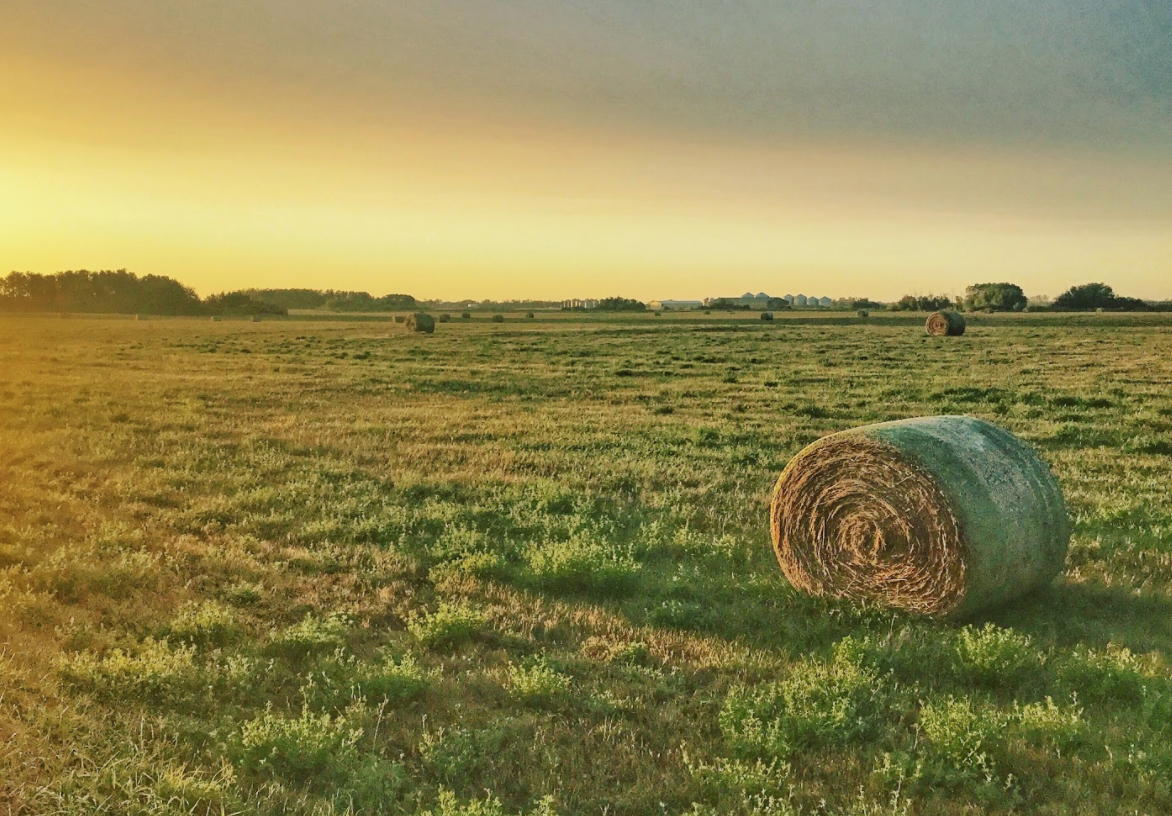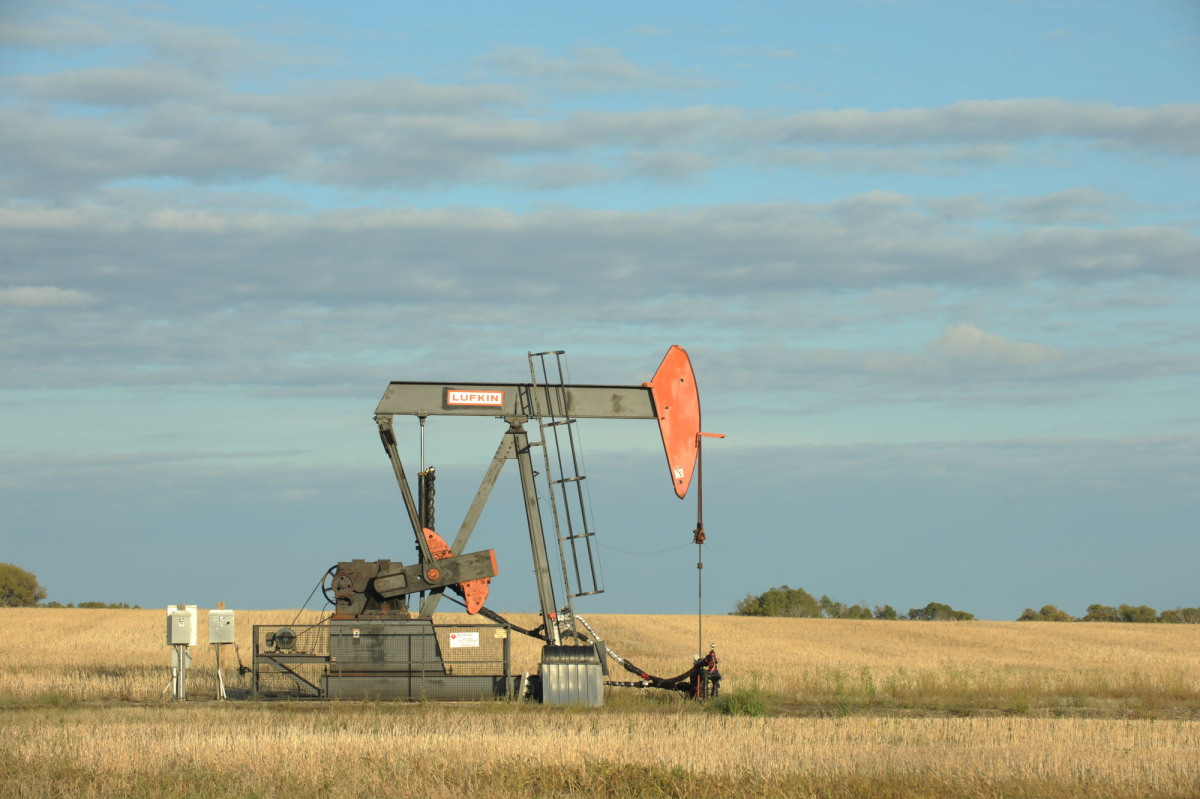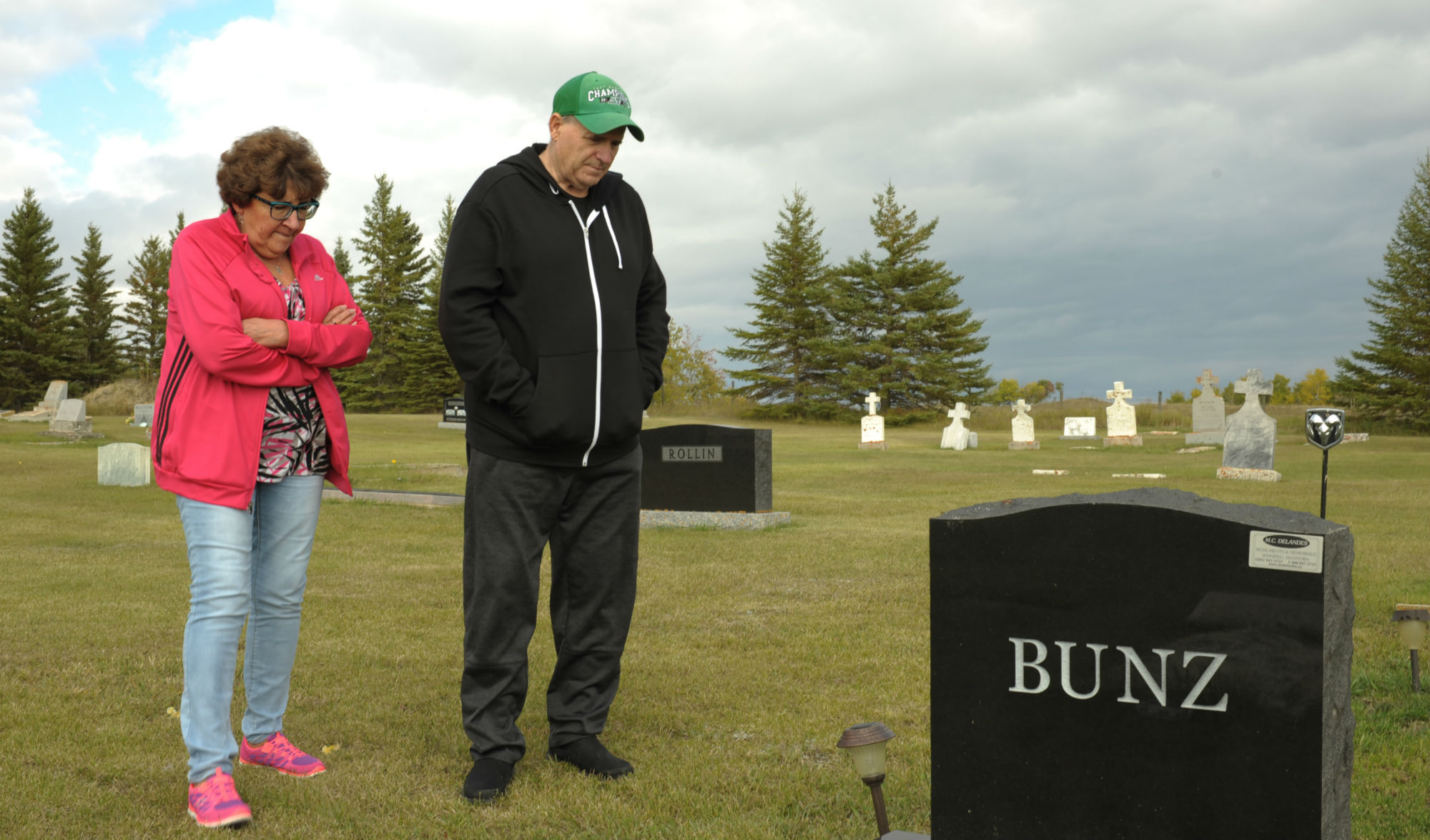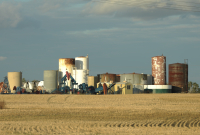Support strong Canadian climate journalism for 2025
This investigation is the second chapter in an unprecedented series investigating the power and influence of the oil and gas industry, and its impacts on Canadian communities. It was carried out over the course of a year by National Observer, the Toronto Star, Global News, and journalism schools at the universities of Concordia, Regina, Ryerson and British Columbia, with support from The Michener Awards Foundation and the Corporate Mapping Project. A complete list of credits follows the story.
Read the first chapter here, and watch the televised investigation on Global National.
It wasn’t hard for a team of journalists to find people in Saskatchewan who have had dangerous encounters with hydrogen sulfide. Also known as H2S or sour gas, it’s a toxic substance that can leak from the wellheads, pump jacks, tanks and flare stacks of the oilfields.
At high concentrations, H2S can bring death within seconds. Insidious and invisible, its victims may die rapidly from respiratory paralysis, or over days from an inflammatory reaction in the lungs.
In interviews, Saskatchewan residents and oil industry workers expressed concerns about the potentially deadly problem, but very few were willing to go on the record and talk about it.
There is a culture of secrecy surrounding the sour gas issue, an unprecedented investigation by National Observer, the Toronto Star, Global News, and four journalism schools has found. It’s a secrecy locals and industry insiders say is fuelled by industry money, the province’s reliance on that money, and fear of threats that are said to have followed those who dare break the silence.

Silenced by fear
Statistics show that the oil and gas industry has some clout in Saskatchewan. Last year, its producers topped up provincial coffers with more than half a billion dollars in tax revenue, and the projections are similar for 2017.
Internal government documents obtained by this investigation lay out nearly five years of industry violations related to toxic sour gas, but they also confirm that key industry players weighed in on the policy reforms — and penalties — they might face as the provincial government tried to crack down on industry's infractions.
In July 2015, field staff from the Saskatchewan Ministry of the Economy — the industry's sole regulator — raised concerns about their relationship with oil and gas companies.
“The role of the regulator needs to be adjusted,” read notes taken during a meeting between ministry officials and industry representatives. “The regulators are acting as consultants in some situations. The role of the regulator is to enforce the rules and if the rules are clear and if enforcement is consistent and clear then, ‘cultural’ changes can be made.”
Asked for this investigation however, about the appearance of a 'close relationship' with oil and gas companies, the Ministry of the Economy declined to comment. In written statements, a spokeswoman said instead that the ministry is “committed to protecting public health, worker safety and environmental standards,” as evidenced by its investments in ramped up inspections and better sour gas monitoring technology.
Despite such reassurances, in the rural communities of southeastern Saskatchewan, locals interviewed for this investigation said the fear of the oil and gas industry’s influence is very real. In the towns and First Nations reserves of rural southeastern Saskatchewan, many families are connected to the industry one way or another, and social ties are tight.
Criticism of oil and gas companies can upset neighbours, family and local businesses — a transgression no one can afford.
“There’s no sense in speaking up because nothing you do will ever change anything,” said one woman — a former industry worker who, along with her husband, agreed to speak about this culture of silence on the condition of anonymity.
The couple had been sickened by H2S near their southeastern Saskatchewan home, but feared that if anyone found out about their clandestine meetings with journalists, word would spread across the province and industry. The husband said he would be blackballed and unable to find work.
The few who have publicly raised concerns about spills in their fields, water being fouled, sacred sites defiled, or gas emissions wafting into their yards told of recriminations. Some lost clients, some lost the friendship of neighbours, and some lost jobs.

A 'lonely place' to stand
Others described stronger tactics.
“People are afraid because, well, (oil companies) have a lot of money, they own everything, and there’s always that promise of bringing in money and with money, you know, hope,” said Marilyn Wapass of the Thunderchild First Nation in west-central Saskatchewan.
Her community has welcomed oil development, but Wapass launched a protest when seismic testing — which involved explosive charges — was conducted near their sundance grounds. Wapass was arrested for trying to stand in the way.
“For myself, personally, only a handful of people have actually come forward and have stood by me and continue to stand with me,” she said. “For the rest of the people, they’ve just kind of turned their backs on me I guess, for whatever reasons.
“It’s been a very lonely place to stand, that’s for sure.”
Wapass was charged and found guilty of contempt of court in 2013, but was not given any fines or jail time. At that time, Justice Shawn Smith said the sentence was a warning.

When shunning crosses the line
Emil Bell of the Canoe Lake Cree Nation knows the feeling of isolation well. He went on a hunger strike last summer after Husky Energy spilled more than 225,000 litres of crude oil and diluent into the North Saskatchewan River — a drinking water source for thousands and home to endangered lake sturgeon.
“People are scared to get involved in (complaints),” he told the investigation. “Even in my own community, people don’t want to hang around me because if they are employed by the reserve, they can lose their job because they’re associating with me.”
Sometimes, such shunning can turn into outright intimidation.
It happened to Shirley Galloway after she raised concerns about sour gas plumes near the town Oxbow, Sask. Galloway is a nurse who, along with her husband Jim, runs a business that trains oilfield workers in occupational safety, including H2S risks.
“(Workers from a local drilling company) were driving down our road, then turning around and shining their lights on our house,” she said in an interview.
For a time, the harassment was consistent and “creepy,” added Jim: “They would shine the lights, turn around, shine the lights back in the house and then slowly creep by the house.”
Many residents and landowners who spoke with reporters on condition of anonymity said having their names published would end their career prospects, since operators can easily nix a hiring or cancel a service contract. Some also thought government regulators couldn’t be relied on to help them, and that broadly speaking, they have been left on their own to negotiate with the oil companies.
An internal government document revealed that Saskatchewan’s Ministry of the Economy would prefer that as well.

Lack of public records on sour gas
“[The ministry] prefers to see operators deal with public complaint without having to be involved,” read the minutes of a meeting held between government and industry on May 28, 2015.
There is often no information on complaints involving H2S, or those injured by it, available to the public.
The investigative team tried to obtain 60 sour gas complaints sent to the Ministry of the Economy over the years, but received a response that those records “do not exist” within the department. Even where reporters obtained copies of complaints sent from residents to ministry officials, the government responded that there were no records.
But the ministry disputes that its H2S database is incomplete or inaccessible.
“The safety risks of sour gas are well known and all incidents involving gas releases are published on the Ministry’s website,” wrote spokeswoman Deb Young in an emailed response to questions.
A check of the website shows that while incidents involving natural gas releases are logged, the involvement of H2S is not. Access to Saskatchewan’s Integrated Resource Information System (IRIS), where complaints are logged, is further restricted to oil companies, landowners and related institutions that have a government-issued ‘associated business’ ID and password.
Even when incidents are reported, the government’s database is often so incomplete and opaque that serious incidents are almost unrecognizable. An incident report from Dec. 22, 2015, for instance, contains a dry, four-sentence summary of an equipment failure in the southeast when H2S gas was vented.
A company report on the incident — obtained through a freedom of information request — recounted a more alarming version of events. The gas cloud drifted half a kilometre in an area with roads, fields and the occasional farm before enveloping three workers at a gas plant.
Four workers were notified by radio of a gas leak and told to evacuate immediately. While alarms sounded, two ran toward the main control room as their personal H2S monitors were going off; the third also attempted to evacuate, the document reads.
A fourth hit the “emergency shut down” button and grabbed a breathing apparatus before checking on the others. Three workers were “effected [sic] by H2S with one worker losing consciousness.”
The company report concluded that the well suffered a “catastrophic” failure, leading to a “high concentration of H2S being emitted to the atmosphere.”
None of that information was made public.

Comments from industry
Obtaining information from some oil and gas companies also proved difficult during the investigation. Crescent Point Energy, a Calgary-based oil and gas company, declined to respond to a question about whether any of its facilities in Saskatchewan had ever been caught with sour gas infractions.
But according to an internal government document obtained by the investigation, Crescent Point was given two suspensions in November 2012 alone — at least one of which was undeniably due to H2S infractions.
“Safe operations are Crescent Point’s first priority,” said Crescent Point in a written statement. “We conduct our business in a manner that minimizes impact on the air, land and water surrounding our operations.”
The company added that it supports strong regulatory enforcement to ensure industry compliance and that it has previously made recommendations to the Saskatchewan government for “monitoring enhancements and mitigation practices.” It declined to reveal what those recommendations were.
Canadian Natural Resources Limited (CNRL), another Calgary-based oil and gas company, declined to comment on this investigation altogether, as its industry association — the Canadian Association of Petroleum Producers (CAPP) — had already responded to interview requests.

A culture of silence
Lori Erhardt, a United Church minister in Oxbow, suffers from breathing problems and must sometimes rely on supplemental oxygen. In 2012, she was forced to leave her home for 17 months to escape what she believes was constant exposure to toxic emissions.
“I’ll be driving... and all of a sudden my voice just goes and this is happened for several years, and then I’ll feel this tightness in my chest,” she said. “I’d land in the hospital about every year... You feel a bit like a canary in a flare zone.”
When she tried to file complaints, she said regional officials seemed “helpless” to take action: “The response was usually, ‘Well, you know, we’re monitoring it.’”
She was instructed to contact people higher up in government, but decided to leave Oxbow instead. “I was so sick,” she said, “I just couldn’t do it.”
The Canadian Association of Petroleum Producers (CAPP), which represents more than 90 oil and gas producers in Canada, said it encourages members of the public to come forward with their concerns. In an interview from CAPP’s headquarters in Calgary, executive vice-president Terry Abel said the lobby group’s focus is on encouraging “best practices” for communication of health and safety information.
“... Consistent with our commitment to public safety and our acknowledgement that unsafe operations are completely unacceptable, totally unacceptable... we believe strongly that anyone who's aware of unsafe operations, whether it's a member of the public or an employee — they have a duty to come forward,” he said.
“And further extension to that, as CAPP or as a member company, or as government... When that information is brought to your attention, you have a duty to do something about that and respond to it.”
Saskatchewan resident Shirley Galloway, who has publicly complained about H2S before, took a direct approach and it backfired. After she sent complaints to contractors about facilities operated by a local company, the company sent her a registered letter asking her to cease communications with the contractors or face legal action.
It ended: “Please govern yourself accordingly.”
If something goes wrong, “if there’s any kind of release or gas, we have nobody to call,” said Galloway.
The culture of silence is the result of industry holding rural communities “hostage,” explained Emily Eaton, a professor at the University of Regina who has studied the impacts of the industry on rural residents for several years, recently as a member of the Corporate Mapping Project.
“Certainly (industry) does provide benefits. No one can deny that there aren’t a lot of jobs produced by industry in rural areas,” she said, “but those come along with an expectation that you’ll remain silent about the types of impacts that you might be experiencing in your backyard.”
“The culture of silence in Saskatchewan is really a culture of fear.”

Authors
- Elizabeth McSheffrey, National Observer
- Mike De Souza, National Observer
- Robert Cribb, The Toronto Star
- Patti Sonntag, Michener Fellow
- P.W. Elliott, University of Regina
Data and documentation journalist
- Michael Wrobel, Concordia University
Researchers
- Jennifer Ackerman, University of Regina
- Madina Azizi, University of Regina
- Janelle Blakley, University of Regina
- Cory Coleman, University of Regina
- Josh Diaz, University of Regina
- Brenna Engel, University of Regina
- Matthew Gilmour, Concordia University
- Céline Grimard, University of Regina
- Jared Gottselig, University of Regina
- Lauren Kaljur, University of British Columbia
- Rebbeca Marroquin, University of Regina
- Matthew Parizot, Concordia University
- Katie Doke Sawatzky, University of Regina
- Michaela Solomon, University of Regina
- Kyrsten Stringer, University of Regina
- Caitlin Taylor, University of Regina
- Steph Wechsler, Ryerson University
Faculty Supervisors
- P.W. Elliott, University of Regina
- Trevor Grant, University of Regina
Series Producer
- Patti Sonntag, Michener Fellow based at Concordia University
Institutional Credits
- Concordia University, Department of Journalism
- Ryerson University, School of Journalism
- University of British Columbia, Graduate School of Journalism
- University of Regina, School of Journalism
- Global News
- The Michener Awards Foundation
- Corporate Mapping Project (Canadian Centre for Policy Alternatives, Parkland Institute, University of Victoria, Social Sciences and Humanities Research Council)
This research was supported by the Social Science and Humanities Research Council of Canada.









Comments
Unmitigated greed at any cost, including human life.
The Peace River country in BC has had and is still having the exact problems and some of those people have given up farms that have been in the family for generations they have tried all the governmental channels and many are afraid and have been threatened as well. Their problems are I believe older than the ones in Sask. and many seem ready to talk as they have nothing to lose.